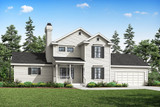The modern farmhouse style has grown into one of the most cherished architectural movements in the U.S., artfully combining rustic warmth with sleek, modern function. This popular design approach highlights open layouts, clean lines, and natural finishes, all while preserving the inviting essence of traditional farmhouse living. Heading into 2025, modern farmhouse plans remain a leading choice in homebuilding, offering the ideal fusion of classic charm and present-day practicality.
To truly understand what it costs to build a modern farmhouse, it’s important to look at current construction data and housing trends. According to the National Association of Home Builders’ (NAHB) most recent 2024 construction cost survey, the average price to build a new single-family home now stands at $428,215 for construction alone, with total sales prices averaging $665,298. For those dreaming of a farmhouse-inspired home, these numbers provide a key foundation for estimating and planning your budget.
Primary Features of Modern Farmhouse Plans
Modern farmhouse architecture stands out through a blend of signature features that give it its unmistakable charm. On the exterior, elements like board-and-batten siding, standing seam metal roofs, and expansive windows define the look. Deep front porches with sturdy columns create a welcoming space for relaxation and neighborly connection, while dormers contribute both visual interest and usable space upstairs.
Inside, modern farmhouse plans favor open-concept designs that unite the kitchen, dining, and living areas into a central hub. Kitchen islands serve as gathering points for cooking and conversation, often accompanied by farmhouse sinks and classic shaker cabinetry. Warm, natural finishes like exposed wood beams, stone details, and wide-plank hardwood flooring add depth and character throughout the interior.
One of the most defining aspects of this architectural style is its strong connection between indoor and outdoor living. Many floor plans include practical features such as mudrooms, screened-in porches, or direct access to patios and decks. This thoughtful design bridges traditional farmhouse roots with today’s lifestyle needs, celebrating nature and comfort in equal measure.
Analyzing the Cost of Construction
Grasping the full scope of construction costs means looking closely at the key factors that shape your overall investment. Based on 2024 data from the NAHB, construction expenses make up about 64.4% of a home’s total price, while the finished lot contributes an additional 13.7%. For a typical modern farmhouse, this means nearly 80% of your budget will go toward building and land acquisition.
Breaking down those construction costs helps clarify where your money is spent throughout the process. Interior finishes take the largest share, accounting for 24.1%—highlighting the high value placed on kitchens, bathrooms, flooring, and custom details central to modern farmhouse living. Major systems like plumbing, HVAC, and electrical follow closely at 19.2%, while framing comprises another 16.6%.
With an average construction cost of $162 per square foot, building a 2,500-square-foot modern farmhouse would cost around $405,000 for construction alone. However, this doesn’t include the lot, soft costs, or builder margin. Once you add in land costs, overhead, financing, and profit, your total investment typically ranges between $650,000 and $750,000 for a thoughtfully finished home of this size.
Location plays a major role in final costs. Material prices, labor availability, and permitting conditions all vary by region. In high-cost areas, expenses may rise by 20% to 40% above average, while more affordable regions may present opportunities to build for less than the national baseline.
In Style Floor Plan options
Modern farmhouse plans are available in a variety of sizes, each tailored to suit different lifestyles, family needs, and financial considerations. Compact designs between 1,500 and 2,000 square feet emphasize efficient layouts without sacrificing the style’s hallmark features. These plans commonly include open living areas, main-level primary suites, and clever built-in storage solutions for maximum functionality.
Mid-range homes, typically between 2,000 and 2,500 square feet, strike an ideal balance for many families. This size range allows for three to four bedrooms, multiple bathrooms, and additional flex spaces like offices or hobby rooms—features that align well with today’s growing demand for versatile at-home environments. They offer just enough space to grow while remaining practical to build and maintain.
For those seeking extra room, modern farmhouse designs over 2,500 square feet provide a sense of grandeur. These larger homes often include separate guest quarters, spacious bonus rooms, oversized kitchen islands, and expanded outdoor living areas perfect for entertaining. While overall construction costs increase with square footage, the cost per square foot may decline slightly due to greater efficiency in materials and labor.
Buyers can also choose between one-story and two-story layouts, depending on their needs. Single-level homes are ideal for aging in place or minimizing stairs, while two-story plans maximize square footage on tighter lots. Your ideal layout will depend on your land, local code requirements, and personal lifestyle preferences.
What to Consider when Planning Your Build
Successfully bringing a modern farmhouse to life involves managing several key factors that directly influence both your construction timeline and overall budget. Permitting requirements differ widely by location, with some jurisdictions mandating in-depth reviews for architectural harmony, environmental impact, or historic area guidelines. Identifying these regulations early helps prevent costly design revisions and project delays.
Choosing the right builder is equally important. Not every contractor has hands-on experience with the materials and craftsmanship that define modern farmhouse architecture. Features like board-and-batten siding, standing seam metal roofs, and custom interior detailing call for specialized knowledge—and may come at a premium in areas where skilled labor is limited or in high demand.
Because of the unique and custom features involved, building a modern farmhouse often takes longer than conventional home construction. Specialty items such as reclaimed wood, artisan hardware, and custom windows may require extended lead times. For this reason, a construction window of 8 to 12 months is a realistic estimate, offering flexibility for delays while ensuring quality results.
Site development costs also play a significant role. Rural lots, which often align with the aesthetic appeal of farmhouse living, may lack basic infrastructure—requiring well drilling, septic installation, or even private drive construction. These additions can increase your budget by $15,000 to $30,000 or more. In contrast, suburban sites with pre-existing utilities typically need only standard excavation and foundation work, keeping costs more predictable and streamlined.
Customizing your Design
Modern farmhouse plans provide exceptional opportunities for customization while preserving the cohesive style that defines the genre. More traditional interpretations lean into historical authenticity, incorporating materials such as cedar siding, copper gutters, and divided-light windows that echo classic farmhouse craftsmanship. While these features may increase material and labor costs, they deliver enduring charm and timeless durability.
On the other hand, contemporary takes on the modern farmhouse favor cleaner lines, larger expanses of glass, and streamlined interior finishes. These versions maintain the warmth and practicality of the style but offer a more modern expression that can be more budget-friendly. Striking the right balance involves identifying which design elements are essential to the look and which can be adjusted to suit cost considerations.
Garage placement and design offer another layer of flexibility. Detached garages preserve the iconic farmhouse feel but add complexity through additional foundations and extended utility runs. In contrast, attached garages offer easier access and reduced costs but must be designed with care to avoid disrupting the home’s architectural flow.
Additional features like finished attics, basements, or dedicated workshop areas can significantly boost usability and value. These bonus spaces often utilize the home’s existing footprint and structural systems, making them one of the most efficient ways to expand livable space without dramatically increasing construction costs. Thoughtful planning ensures these enhancements align with both budget and lifestyle goals.
Designing and Budgeting Your Modern Farmhouse Build
Building a modern farmhouse is a major financial undertaking that demands thoughtful planning and a realistic approach to budgeting. Current data suggests that total project costs—including land, construction, and finishing—typically range from $250 to $300 per square foot. This figure reflects the full investment from land purchase through final move-in.
Financing a custom home differs from buying an existing one. Most builds require construction-to-permanent loans, which are structured in phases and involve interest-only payments during construction. Familiarizing yourself with these loan options early on is essential to maintaining consistent funding through each stage of the project.
One of the benefits of modern farmhouse plans is their enduring market appeal. The blend of classic design and modern functionality continues to perform well in resale scenarios. That said, overly specific customizations or unconventional layouts may narrow your resale audience, especially if life circumstances prompt an earlier-than-expected sale. Finding a balance between personal expression and broad market appeal protects your investment while delivering a home tailored to your lifestyle.
From choosing the right plan to stepping inside your finished home, building a modern farmhouse is a journey that requires patience, preparation, and clarity. Knowing the full scope of construction costs, understanding local variables, and working with experienced professionals will help you make well-informed decisions. Whether you’re planning a modest 1,800-square-foot retreat or a spacious 3,000-square-foot home for extended family, success begins with a clear vision and a solid foundation—both financially and structurally. Here at Associated Designs, our talented team of designers can bring your vision to life, offering expert guidance and custom plan modifications to ensure your home perfectly reflects your needs, lifestyle, and budget.


